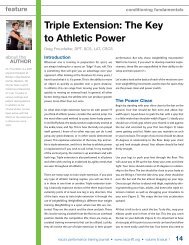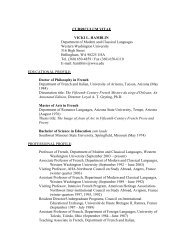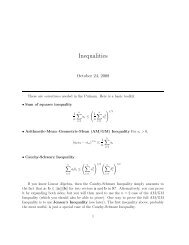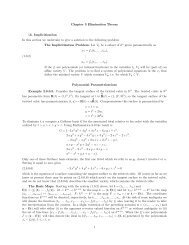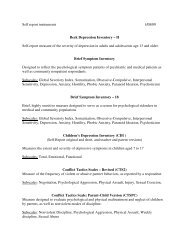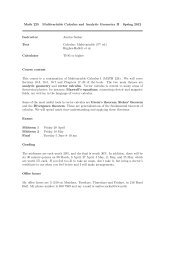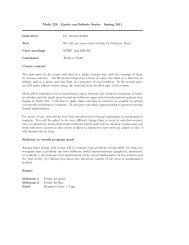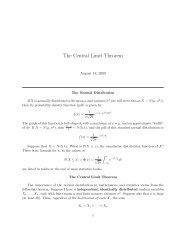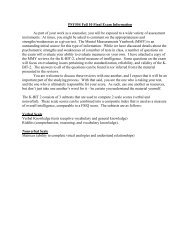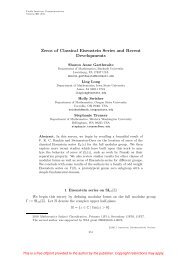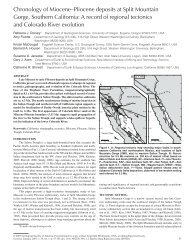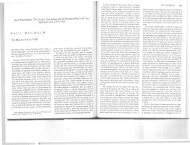Can There Be A Knowledge-First Ethics of Belief? - Western ...
Can There Be A Knowledge-First Ethics of Belief? - Western ...
Can There Be A Knowledge-First Ethics of Belief? - Western ...
Create successful ePaper yourself
Turn your PDF publications into a flip-book with our unique Google optimized e-Paper software.
20 This assumes, pace Williamson (2000), that the following conjunction is false: knowledge<br />
is identical to evidence and knowledge entails belief. Should that conjunction hold,<br />
the up-to-now evidential duplication theory would have the problem <strong>of</strong> compulsory completeness.<br />
21 Following Bird’s (2007) approach to doxastic justification, we could invoke the notion<br />
<strong>of</strong> “corresponding propositions” to get around this problem <strong>of</strong> necessary falsehoods. The<br />
strategy here would be drop the idea that we should believe p iff p is known by some <strong>of</strong><br />
our up-to-now evidential duplicates, and replace it with the idea that we should believe<br />
p iff some proposition corresponding to p is known by some <strong>of</strong> our up-to-now evidential<br />
duplicates. In cases where p is necessarily false, then, we should nonetheless sometimes<br />
believe p, because propositions corresponding to p are known by our up-to-now evidential<br />
duplicates. Perhaps this line <strong>of</strong> thought can be made to work, but it leans hard on the new<br />
notion <strong>of</strong> a “corresponding proposition”. Until we can say something informative about<br />
that new notion, the approach seems underspecified.<br />
22 Here is one more attempt to make the appeal to evidence work out. Combining some<br />
standard evidentialist ideas from Conee and Feldman (1985) with some knowledge-first<br />
ideas from Williamson (2000), we might (a) identify one’s evidence with one’s knowledge,<br />
and (b) conjecture that one should believe (or withhold on) p iff believing (or withholding<br />
on) p fits one’s evidence. However, there are problems with this view. Evidence may not be<br />
identical to knowledge. And even if it is, there are still other problems. Without an account<br />
<strong>of</strong> “fit”, the view is very underspecified. And it is hard to see what an adequate account<br />
<strong>of</strong> “fit” would look like. The most obvious accounts <strong>of</strong> fit define that notion in terms<br />
<strong>of</strong> probability, so that believing p “fits” one evidence just in case p is rendered probable<br />
enough by one’s evidence. But then how probable is “probable enough”? Presumably<br />
(but see Whitcomb (forthcoming) for some ways to relax this assumption), there is some<br />
value x such that for any proposition p, p is rendered “probable enough” by your evidence<br />
iff its probability given your evidence is at least x. What then is the value <strong>of</strong> x? If x = 1,<br />
the view becomes too skeptical, entailing (for instance) that we should believe relatively<br />
few things on the basis <strong>of</strong> testimony. For example, suppose that you are irrationally<br />
unwilling to accept the testimony <strong>of</strong> others, perhaps because your father constantly lied<br />
to you during your childhood. A wholly trustworthy person might tell you that the store<br />
has pumpkins on sale. You might decline to believe this person, coming to believe only<br />
that he said pumpkins are on sale, and not that pumpkins are on sale. If your evidence<br />
is identical to your knowledge, and you should believe only those propositions having<br />
probability 1 given your evidence, then you are making no mistake in this case, because<br />
in this case you should not believe that the store has pumpkins on sale. But in fact, in<br />
this case you are making a mistake; you should believe that the store has pumpkins on<br />
sale. So the view is too skeptical if x = 1. But if x < 1 the view is too credulous, entailing<br />
that we should believe that our lottery tickets are losers, even before the drawing takes<br />
place. Thus we are left with either an underspecified theory or a false theory - a theory<br />
underspecified due to the underspecified notion <strong>of</strong> fit, or a theory false due to being either<br />
too skeptical or too credulous. This is the standard theoretical pattern: we get either<br />
a counterexample-free theory that is uninformative, or an informative theory that has<br />
counterexamples. We could try to get out <strong>of</strong> the pattern by replacing the notion <strong>of</strong> fit<br />
with some sort <strong>of</strong> shiny new Bayesian machinery. But this strategy is unpromising: see<br />
(Williamson, 2000, 184-237) for some steps in its direction, and Whitcomb (2008) for a<br />
case that these steps can’t get us out <strong>of</strong> the pattern.<br />
29



